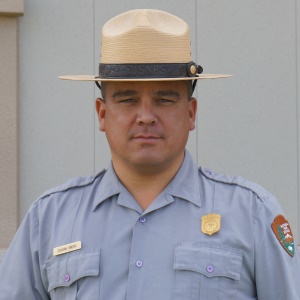Park Ranger
Missouri National Recreational River
Responsibilities: Smith specializes in interpretive and educational programs. This involves community outreach, organizing and hosting programming in the park, and supervising seasonal employees during the summer. He also coordinates volunteer work in the park, including League-led efforts such as river clean-ups, aquatic invasives education (Clean Boats), and educational festivals.
Years in current position: 15
Years with the Park Service: 15
 Career path:
Career path: Smith grew up on a ranch near Pierre, South Dakota, as a member of the Cheyenne River Sioux Tribe. He served 10 years in the U.S. Air Force and 14 years in the Air National Guard. After earning a degree in environmental studies, Smith worked in the tribe’s Department of Environmental and Natural Resources. He later joined the National Park Service as an interpretive ranger at the Missouri National Recreational River.
What makes my park special: “The abundance of recreational opportunities. It’s a national water trail. There’s been lots of growth in canoeing and kayaking and less motor boating over the last five years. Birders come, too. It’s one of the few places where there’s a mix of eastern and western species. The river provides the habitat.” “Although only one-third of the Missouri River looks similar to how Lewis and Clark and native peoples saw it (the rest has been dammed and channelized), it has a unique place in American history. It was a gateway to the West, the interstate of that era. When you come here, you understand.”
Typical day: “Each one is unique and enjoyable. I might set up an exhibit one day then do a program with kids the next. This fall, a big project is producing our first park film — one main segment plus five short ones for theaters and our mobile ranger stations. It’s ‘eye candy’ and explains why [people should] come, including the local tribal history and the history, uses, and geology of the Missouri River.”
Biggest challenge: “Not enough staff to do all that we need to do. Also, the geography of the river. There’s no gate and no fee, so people might not know they’re in a national park. It’s tough to convince locals this isn’t just a river and [explain] why there are regulations. There’s a reason it looks pristine. It wouldn’t be this way without the National Park Service.”
Best part of the job: “The diversity of the work. One day I’m at my desk, the next I’m outdoors. I meet lots of people. I try to convince them of the importance of the river.”
Advice for visitors: “For birders, the main spring migration is from mid-May through June. In the fall, millions of geese pass through here between the end of September and early October. The songbirds are quicker in October.” “Ask lots of questions. There are limited access points to the river — mainly overlooks, but no gates. The park is more of an idea. You’ve got to find it. It’s spectacular once you do.”
My favorite national park: “My own! Otherwise, Theodore Roosevelt National Park. I grew up in western South Dakota. I love the big, open country and the Missouri Breaks. It reminds me of home and western culture.”
Learn more about our national parks! View historic photos, listen to audio on how the film, "Our National Parks: America's Best Idea," was created, and learn about activities and events the park system offers.